What Do Wasps Eat?
A lot of people are afraid of wasps. Their cousins, the bees, on the other hand, are getting all the love in the world. We take care not to further deplete the bees’ numbers since they are dwindling as of this moment; wasps do not get the same kind of attention we give the bees and we are better off not being bothered by them.
Why are wasps getting a bad reputation among humans and bees to get the love? Bees are generally seen as gentle creatures. They help pollinate plants and some even make honey.
In contrast, wasps are such a nuisance to us just by their presence alone. They ruin our outdoor picnics just by being around us. Worse, some wasp species are aggressive and they sting. Their stings, by the way, are painful. Are wasps really no good to us? Do they contribute anything to society? Are they such the scoundrels we always think them to be? There should be more to the wasps than just being a nuisance. Maybe they help the ecology by eating off the bad stuff. Let us give them a closer look.
Overview Of Wasps
Wasps can be distinguished from the bees through their narrow waists and pointed lower abdomens. They come in different colors; they can be yellow, brown, blue, or red. There are around 30,000 species of wasps, and the largest can grow as long as 2 inches in length. The smallest is only .0055 inches in length and is actually the smallest insect in the world – the chalcid wasps which is a solitary wasp.
Wasps are divided into two subgroups: solitary wasps and social wasps. Social wasps include the yellowjackets, paper wasps, and hornets. These wasps set up and live in colonies. Of the 30,000 species of wasps, only a thousand are social.
To give you an idea of how a wasps’ colony starts off every year, a single queen builds a colony out of nothing. This queen was fertilized the previous year and hibernates the rest of the winter, only to emerge in the spring. She would then build a nest where she would lay her eggs. When these eggs hatch, she would take care of her young. Her female offsprings would become her workers. Eventually, these workers would soon increase in number, expanding the nest. Their numbers can increase to as much as 5,000 wasps. This cycle happens every year, since every wasp in the colony would die, including the queen. The newly fertilized queens would be the only ones to survive the winter. The social wasps have stingers that they use only for self-defense.
Solitary wasps do not form any colonies. This subgroup is the bigger group. Some solitary wasps build nests and some do not. An adult female solitary wasp looks for food alone. She builds a nest for herself and her offsprings, and not for a colony. Unlike the social wasps, the solitary wasps use their stingers for hunting. For food, they prey on insects like beetles, spiders, crickets, and aphids. They only attack humans when provoked.
They feed their larvae with insect meat and have the ability to paralyze their prey. This comes in handy so that when their larvae are ready to feed, they would be fed with fresh meat instead of rotting carcasses. Solitary wasps are further divided into three groups: squatters, builders, and , diggers. The squatters do not build their own nests and use only holes that are already existing. The builders build their own nests. The diggers dig holes on the ground for their nests.
Types Of Wasps
Below is a list of the most common wasps in the United States.
Paper wasps
They are among the most common wasps. They help rid gardens of pests, but they sting humans too and can be quite painful. They are called paper wasps because their nests are made of paper-like materials made out of chewed wood. These nests are water-resistant.
Solitary wasps
Solitary wasps are identified by their long and thin bodies. They usually fly alone and are not aggressive. They prey on pests like beetles and aphids.
Wasp Hornet
A wasp hornet is highly aggressive and can attack without provocation and their stings are painful. They are an inch long, dark in color with white, cream, or yellow markings on the abdomen, thorax, and face. They also make paper-like nests out of chewed wood and their saliva, just like the paper wasps. Their nests are large and are usually found in wooded areas and are hanging on tree branches. They can also build nests at the side of houses and utility poles. Removal of their nests is very important since they can be dangerous. Ask help from the professionals in doing so.
Yellowjacket wasps
The yellowjacket wasps are said to be the most dangerous. They are ½ inches to ¾ inches long, black in color with yellow markings. Yellowjacket wasps like “human food” that is why they are usually spotted near trash cans looking for food. If you see their nest within your property, it is important to have it removed immediately because they sting when they feel threatened and are highly territorial. Another behavior of yellowjackets is that they do not travel far from their nests. This means that if you spot one, their nests are just nearby.
What Do They Eat?
Typically, wasps eat insects, plants, fruits, nectar, and honey. The adult wasps do not actually eat the insects, and instead paralyzes them and feed them to their larvae. Another interesting fact about wasps is that after paralyzing their prey, they then insert their eggs inside the prey; the prey becomes host to these eggs. The host would remain alive until such time as the parasitoid larvae emerge as adult wasps.
Wasps prey on spiders, caterpillars, beetles, crickets, and aphids. Some species of wasps are even used to control agricultural pests. In South America, farmers there use parasitic wasps to control the population of sugarcane borers. They are also used in greenhouses (structures made of glass that allow sunlight in wherein plants that require regulated conditions are grown inside) to control whiteflies that attack tomatoes and cucumbers.
As previously mentioned, yellowjacket wasps eat what humans eat. That is why they are usually found scavenging for food in garbage bins. And p aper wasps eat wood. The wood they chew also helps them create paper-like nests.
Control
Wasps are known as nuisance pests, and can even sting when they feel threatened or when they think we are trespassing their territory. They must be removed from your immediate vicinity. Here are some ways to get rid of them:
- Wasps forage for food in trash cans. Cover garbage bins and trash cans to cut off their food source. Do not leave any edible materials outdoors.
- To avoid being stung by wasps, do not wear sweet smelling or floral perfume. Wasps are attracted to sweets, even by its scent. Once they smell you wearing this, they might come near you and investigate.
- Fill in spot holes in your yard. These have the potential to become homes to yellowjacket wasps.
- Avoid carrying around opened soft drink cans. Since wasps are attracted to sweet items, you may soon find one inside the soda can.
- You can use traps. You may purchase commercial wasp traps in home-improvement stores.
- Seal potential entry points in your house. You might just soon find one in your kitchen looking for food.
Is There A Good Side To The Wasps?
We have all been looking at the bad side of wasps, which makes us wonder, are there any good at all? Well, like bees, wasps are very good pollinators. By traveling from one flower to another due to their penchant for nectar, they also transfer pollen.
Like we have mentioned before, they are also used to control pests by farmers. Without them, our gardens and crops would be destroyed by pests.
Since wasps sting when they feel threatened, it may be best to get rid of them when they are within our yard. You may call in the best pest control management in North Carolina, Go-Forth Pest Control if you need to remove a wasp nest in the garden.
Simply The Best In Pest Control
Say goodbye to your wasp problems with Go-Forth Pest Control. Go-Forth has excellent experience in controlling pests like wasps, mosquitoes, cockroaches, mice, moths, and many others. They have a team of expert technicians who are highly skilled and well trained while using only the best, the latest, and the most advanced equipment in the business. Their methods are family-friendly and pet-friendly, so you are assured of your family’s safety.
Go-Forth Pest Control is a family-owned company that has earned the trust of residents and businesses in North Carolina for more than 50 years. For more information, just click here or dial 336-841-6111.
What do wasps do?
Wasps have generally earned themselves a bad reputation. But despite their occasional aggression, these insects play an important role in the ecosystem.
There are over 7,000 wasp species living in the UK, comprising a huge variety of solitary and social species. The majority are parasitoids, which have young that eat insects or spiders alive. However, the most commonly seen wasps are the black and yellow social species.
Colonies of social wasps are considered annoying pests – they often nest in manmade structures and deal out painful stings if you get too close. Yet despite our grievances, the ecosystem actually relies on these underappreciated insects.
So what are the benefits of wasps?
Natural pest control
Wasps are probably best known for disrupting summer picnics, but they are actually very important in keeping the ecosystem balanced.
Without wasps, the world could be overrun with spiders and insects. Each summer, social wasps in the UK capture an estimated 14 million kilogrammes of insect prey, such as caterpillars and greenfly. Perhaps we should be calling them a gardener’s friend.
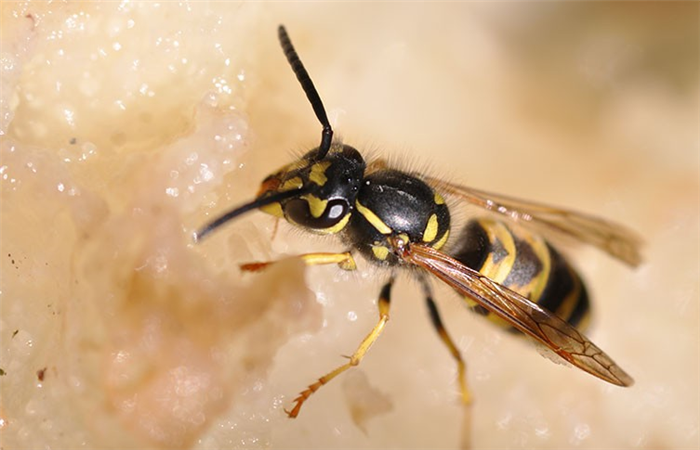
A common wasp (Vespula vulgaris) feeds on a pear. Adult wasps only feed on sugars, but hunt other invertebrates to feed to their offspring. © Aiwok via Wikimedia commons (CC BY-SA 3.0)
Dr Gavin Broad, a wasp expert at the Museum, says, ‘Wasps are generally apex predators – so if they’re not doing well, it indicates that there is something wrong with the world.’
Wasps are hugely beneficial to their native ecosystems due to the sheer amount of insects they capture. But their voracious appetites can cause problems if a species spreads or is introduced to new areas and their numbers aren’t kept under control, such as in New Zealand, where there are no native social wasps.
‘Where common and German wasps have been accidentally introduced to New Zealand, they’ve been stripping caterpillars out of forests. This is having a huge ecosystem impact and the native birds have been declining.’
What do wasps eat?
Adult wasps don’t eat the prey they kill – they feed it to their young. Social species capture insects, chop them up and carry parts back to the nest.
Some solitary species are more sinister. For example, most spider wasps paralyse arachnid prey using a venomous sting. Their larvae then eat the victim alive. There are almost 5,000 species of spider wasp worldwide, including 44 species in Britain.
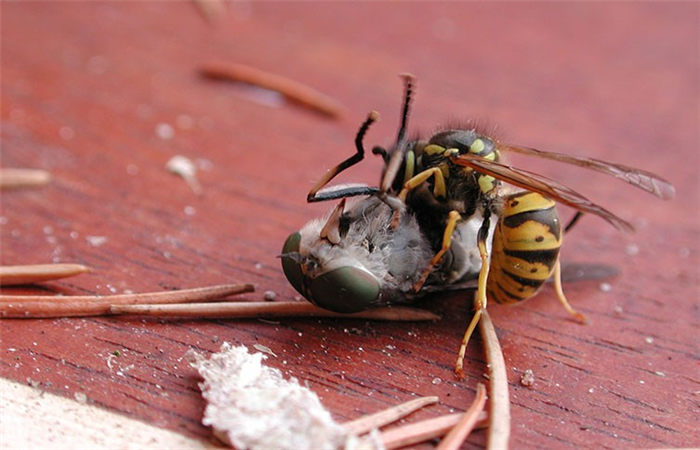
A common wasp (Vespula vulgaris) captures a horsefly, which it will chop up and feed to its larvae © Robert Goossens via Wikimedia Commons (CC BY-SA 3.0)
Instead of eating insects and spiders, adult wasps – both social and solitary – only feed on sugars. In the wild, sugars come from flower nectar and honeydew produced by aphids. Wasp larvae also produce a sugary liquid that the adults consume.
‘There is also a lot of sugar at pubs and picnics. Adult wasps don’t live very long, so they don’t really need protein. They’ve just got to load up on carbs,’ explains Gavin.
When on the hunt for nectar, wasps can also become accidental pollinators by travelling from plant to plant carrying pollen. While their contribution to pollination may not be as substantial as bees’, wasps still play a valuable part.
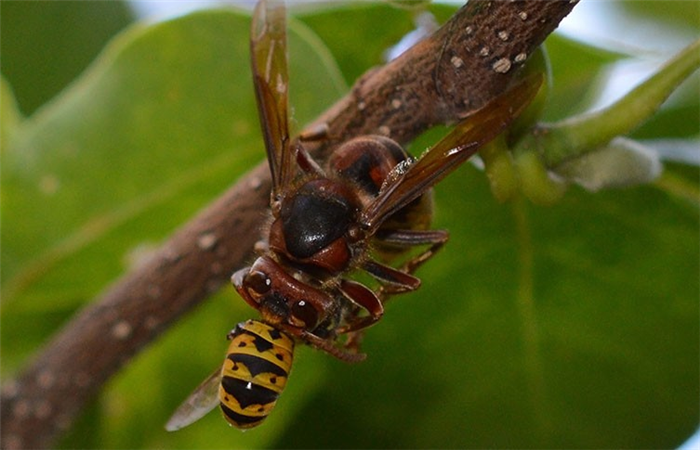
Wasps are also a food source for other animals – including other wasps. In this image a European hornet (Vespa crabro) has captured a smaller social wasp, most likely a German wasp (Vespula germanica), which will then be chopped up and fed to the hornet’s own larvae. © Dimitǎr Boevski via Wikimedia Commons (CC BY-SA 4.0)
Where do wasps go in winter?
The lives of wasps in the UK are dictated by the seasons. They need large amounts of insects to feed their young, so are only active in the warmer months, when food is readily available.
The worker wasps of social species die off late in autumn, while recently emerged females hibernate. They spend the cold months in sheltered areas such as lofts and animal burrows.
But only some survive the chill. Those that do emerge when the weather warms up begin to form new colonies. After building a small nest, the new queen lays eggs of the first workers.
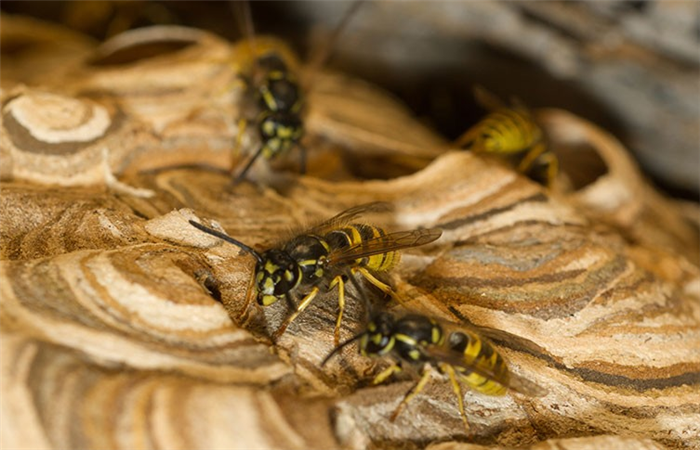
Four common wasps on the outside of a paper nest © IgorArenz via Wikimedia Commons (CC BY-SA 3.0)
Gavin says, ‘At the beginning of April and May the colony is really small, with just a few workers. Growth is slow until you get to a certain mass, then it’s almost exponential growth.’
As the colony increases in size, so does the ability of the workforce to forage and feed the young, thus maintaining a cycle of growth.
Ancestors of the wasps most commonly found in the UK nested in cavities. This has resulted in species that thrive in manmade structures such as sheds and lofts. This sometimes makes wasps a pest problem when the colony mass increases.
But in Britain, colonies never reach their full potential as their growth is curtailed by winter. In parts of the world where winters are milder, colonies can continue to grow.
‘I think the biggest common wasp nests are in Australia,’ says Gavin. ‘There can be as many as two million workers. When you get a huge nest, you can imagine the large biomass of insect prey they’re taking in.’
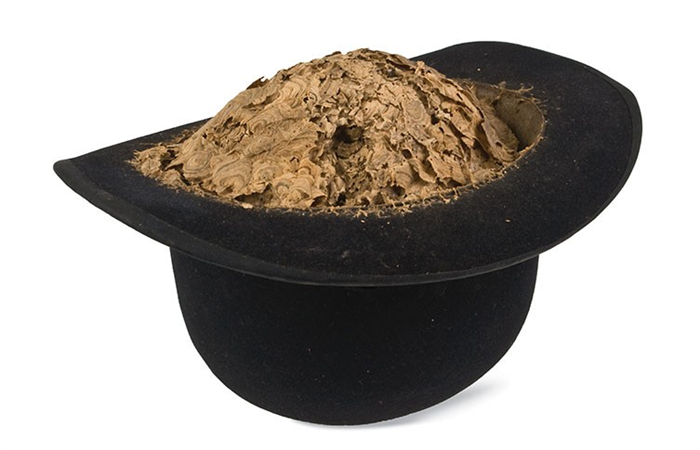
Social wasps build nests in a variety of environments, both natural and manmade. This nest inside a bowler hat was built by a colony of common wasps.
Why do wasps sting?
Wasps use their venomous sting to subdue prey and defend their nest. They also use it to defend themselves.
Wasps sometimes sting us as they see us as a probable threat, even if we don’t really pose one.
Unlike honey bees, wasps don’t lose out by stinging us. Honey bees sacrifice their lives as their stings have a set of tiny barbs that hook into the skin.
‘Honey bees have weak attachments in their abdomen. So when it pulls away the sting remains attached to you and it basically pulls away the entire muscle system around the sting. It’s a bit brutal,’ explains Gavin.
Wasps have smooth stings that can easily be pulled out of the skin by the insect – with the exception of a few South American species. If they run out of venom, they simply make more.
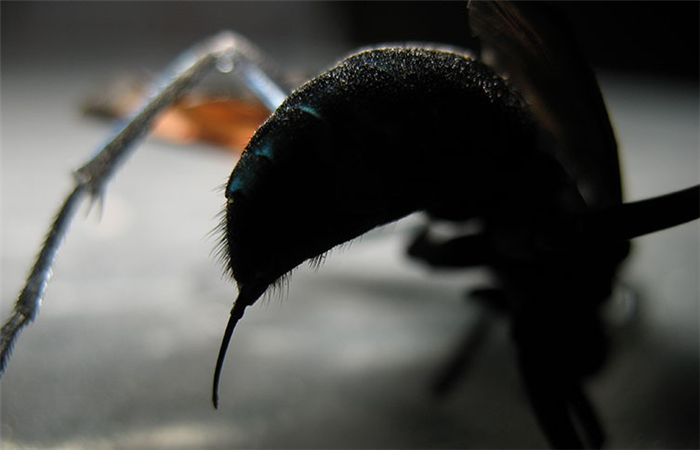
The smooth sting of a tarantula hawk (genus Pepsis). Found in southern USA and South and Central America, these species are regarded as having the most painful sting of any wasp. © Rankin1958 via Wikimedia Commons (CC BY-SA 3.0)
Common British wasps
If you see a wasp in Britain, it will most likely be either the common wasp (Vespula vulgaris) or the German wasp (Vespula germanica). These species are very similar in size and colour – predominantly yellow with black markings.
Gavin adds, ‘The red wasp (Vespula rufa) and the tree wasp (Dolichovespula sylvestris) are also common. The Saxon wasp (Dolichovespula saxonica) only arrived in Britain in the 1980s and it’s mainly common in the south.
‘The European hornet (Vespa crabro) is quite common in parts of the south, but it is more of a woodland species,’ says Gavin.
The European hornet is the UK’s only native hornet species and is the largest of our social wasps. Their bodies are also yellow with a dark pattern – although it has a sting that is more painful than other social wasps in Britain, usually leaving the stung area throbbing for a few hours.
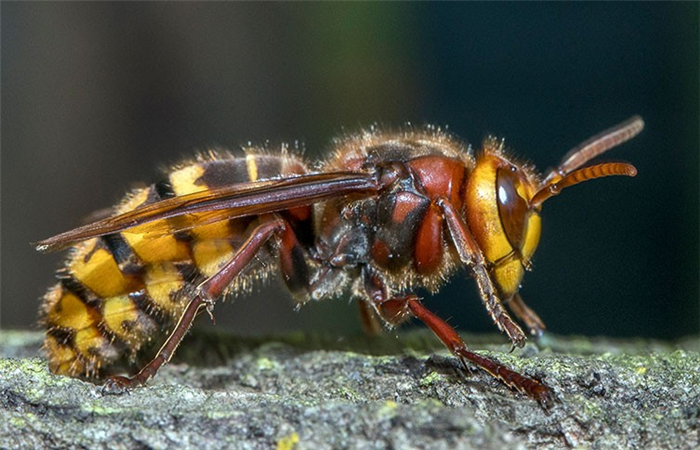
The European hornet (Vespa crabro) shares a similar colouration and pattern with a number of other social wasps. This is a form of Müllerian mimicry. © Jerzy Strzelecki via Wikimedia Commons (CC BY-SA 3.0)
Although wasps may cause us strife in the summer months – and leave some to question the point of them – these insects play a crucial role in maintaining harmony in the ecosystem. We certainly would not be able to cope in a world without them.
We hope you enjoyed this article…
. or that it helped you learn something new. Now we’re wondering if you can help us.
Every year, more people are reading our articles to learn about the challenges facing the natural world. Our future depends on nature, but we are not doing enough to protect our life support system.
British wildlife is under threat. The animals and plants that make our island unique are facing a fight to survive. Hedgehog habitats are disappearing, porpoises are choking on plastic and ancient woodlands are being paved over.
But if we don’t look after nature, nature can’t look after us. We must act on scientific evidence, we must act together, and we must act now.
Despite the mounting pressures, hope is not lost. Museum scientists are working hard to understand and fight against the threats facing British wildlife.
For many, the Museum is a place that inspires learning, gives purpose and provides hope. People tell us they ‘still get shivers walking through the front door’, and thank us for inspiring the next generation of scientists.
To reverse the damage we’ve done and protect the future, we need the knowledge that comes from scientific discovery. Understanding and protecting life on our planet is the greatest scientific challenge of our age. And you can help.
We are a charity and we rely on your support. No matter the size, every gift to the Museum is critical to our 300 scientists’ work in understanding and protecting the natural world.
From as little as £2, you can help us to find new ways to protect nature. Thank you.
Common wasp
You might be surprised to see quite a few wasps around during late summer. But why do they like your jam sandwiches so much?
Latin name: Vespula vulgaris
Notable feature: Striking black and yellow warning stripes
Where in the UK: Throughout the UK
What do wasps do?
- Wasps eat flies, aphids, caterpillars and other invertebrates, making them an important insect-controlling predator.
- Wasps are amazing architects, building hexagonal paper nests from chewed up wood.
- Wasps are important pollinators.
- Wasp nests provide a home for some of our most beautiful, pollinating hoverflies.
How many species of wasp are there?
There are approximately 9,000 species of wasp in the UK. These include the parasitic wasps, some of which are so tiny, they can barely be seen without a micropscope. 250 of these are the larger wasps which have have a stinger. Only nine of these are social wasps which form large nests, the majority are solitary and cause no upset to humans.
The Common wasp (Vespula vulgaris) is found throughout the UK in almost all habitats, including woodland and urban areas. They are nicknamed jaspers in the Midlands, deriving possibly from the Latin for wasp, vespa, or from the similarity in looks to the striped mineral jasper.
As the commonest UK wasp they are easily identified by most people. Adult workers (always females) measure 12-17mm whereas the queen is around 20mm. Iconic black and yellow stripes give a clear warning to other animals that these insects are dangerous. With the abdomen split into six segments, one black/yellow stripe on each, the Common wasp is very similar to the German wasp (Vespula germanica). The key difference is that Common wasps lack the three black dots on the head and distinct black dots on the back as they merge with the back stripes.
Wasps are magnificent architects
In late spring, large wasps can be seen. These are queens who are looking for suitable nest sites. These can be deserted mammal holes, cracks in walls or holes in trees. The nests are made from chewed up wood and wasp saliva which creates a paper-like material.
Wasps are social animals
A queen will begin by building a cylindrical column known as a petiole which is covered by a chemical produced by the queen which repels ants. When she’s finished, she produces a single cell and surrounds it with a further six cells, giving the cells their characteristic hexagonal shape. She continues building cells in a layer until she has 20-30 then lays an egg in each. Once the eggs have hatched she divides her time between feeding the larvae and nest building.
At full size larvae spin a cover over their cell until they have developed into adult workers. These are the smaller wasps, seen later in the summer, who are gathering proteins to feed the larvae and sugars to feed themselves. It’s this need for sugar that attracts them to your jam sandwiches or fizzy drinks. With enough adults fully grown the queen can focus on reproduction and is then fed by the workers in the nest. Each nest may contain 5,000-10,000 individuals and is spherical in shape.
In late summer new queens and male drones emerge from the nest. Each colony contains only one queen and after mating in late autumn the new queens overwinters in holes or other sheltered locations. Colonies only last one year and once the new queens departs all the other wasps in the colony die.
Why are wasps after my picnic?
Towards the end of September the nests are at maximum capacity, with lots of adults and few larvae. This means that there will be lots of wasps visible but also affects what food they look for. While the adults feed on nectar the larvae are fed on insects. When feeding larvae, adults obtain a small, sugar rich droplet of liquid from the young. With fewer larvae the adults don’t need to look for as much protein but do need more sugars and carbohydrates. It is because of this need for carbohydrates that wasps might go for your crisps rather than your jam this month.
Why do wasps sting?
Wasps have a sting to allow them to capture and immobilise their prey (such as aphids, caterpillars, flies and spiders). They may also sting to defend their nest.
What Do Wasps Eat?
Few creatures on planet Earth fill people with as much fear as wasps. These tiny insects can pack a painful sting, and a swarm can potentially prove life-threatening in certain circumstances. Wasps belong to the order Hymenoptera and look like a mix between a bee and an ant. Most wasps bear distinctive yellow and black markings and range in size from microscopic to several inches long. You can find them on every continent except Antarctica and in almost every kind of habitat. While some wasps are social, most are solitary and only come together to mate. Wasps feature prominently in history, movies, and music, and have long been both feared and praised. Due to this fear, many people continue to misunderstand wasps and the role they serve in the environment. For example, if pressed, many people would struggle to answer the question, “what do wasps eat?”
In this article, we’ll attempt to clear up some of the confusion surrounding wasps by exploring what they eat. First, we’ll start off with a brief overview of what wasps like to eat. Then, we’ll examine how wasps use their senses and skills to hunt and forage for food. Next, we’ll compare what wasps eat in the wild versus what they eat in captivity. Finally, we’ll end with a discussion of what baby wasps eat. So, get ready, because we’re about to answer the question, “what do wasps eat?”
What Do Wasps Like to Eat?
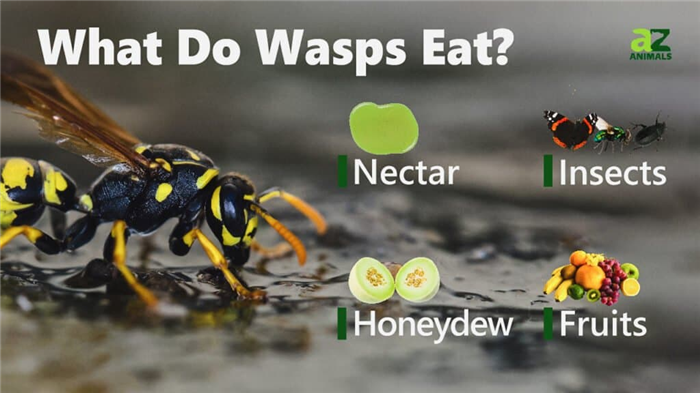
Depending on the species, wasps eat either insects or fruit and nectar.
The food that wasps eat varies depending on the species and the age of the wasp. Some species predominantly just drink nectar from flowers, while others are hunters and scavengers. Meanwhile, while some adult wasps are carnivores and others nectarivores, wasp larvae are almost exclusively carnivorous. This discrepancy has led many people to be confused as to what wasps like to eat. But don’t worry, this is why we’re here to help dispel the confusion. By and large, adult wasps are drawn to food with high sugar content or high protein content. They target a wide variety of prey and forage for plants and that can satisfy their cravings. To make this easy on you, we’ve identified 9 foods that wasps usually like to eat. These foods are eaten by adult wasps, their larvae, or both, depending on the species. The 9 foods include:
- Fruit
- Honey
- Aphid honeydew
- Nectar
- Wasp larvae secretions
- Insects
- Spiders
- Carrion
- Larvae
How Do Wasps Hunt and Forage For Food?
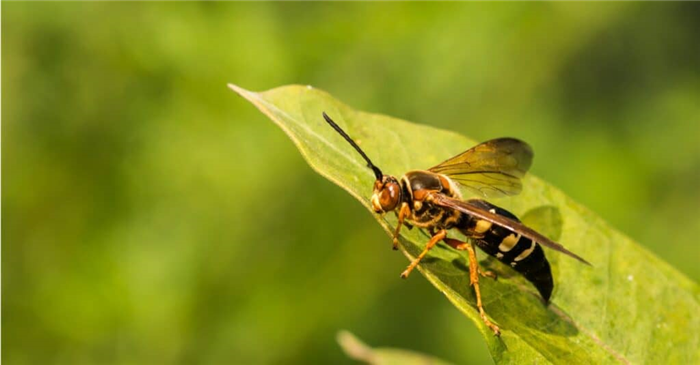
Wasps possess excellent smelling and vision capabilities.
Wasps possess keen senses that help them hunt and forage for food. They have an acute sense of smell, which is reportedly even more sensitive than that in dogs. Wasps can identify odors using scent receptors in their antennae, which allows them to find nectar, dead insects and animals, and sugary food from far away. Their smell receptors often attract them to picnics, flower beds, and trash piles, all of which emit strong odors. Once they are close enough to their prey or food, wasps then rely on sight to hone in on their target. They can detect color variations, which they use to determine if an insect is an appropriate prey. Additionally, wasps use their hearing to figure out if insects are already serving as hosts for other parasitic wasps. Their sense of touch and taste also help them to find their way and identify tasty foods.
Wasps employ several different strategies when hunting and foraging for food. Non-parasitic adult wasps spend most of their time foraging for nectar, fruit, and other sugary food. When a female is ready to lay her eggs, she will find a suitable host. She then stings and paralyzes the host, then deposits her eggs inside its still-living body. Once her eggs hatch, they will emerge and consume the hosts. Meanwhile, non-parasitic wasps spend most of their time hunting and scavenging for animal matter. These wasps are attracted to carrion such as dead insects and animals. In addition, they also hunt for live prey. Upon finding a live insect, a wasp will usually sting it with its stinger to paralyze it. It will then either consume the insect on-site or chop it up into pieces and bring it back to its nest.
What Do Wasps Eat in the Wild?
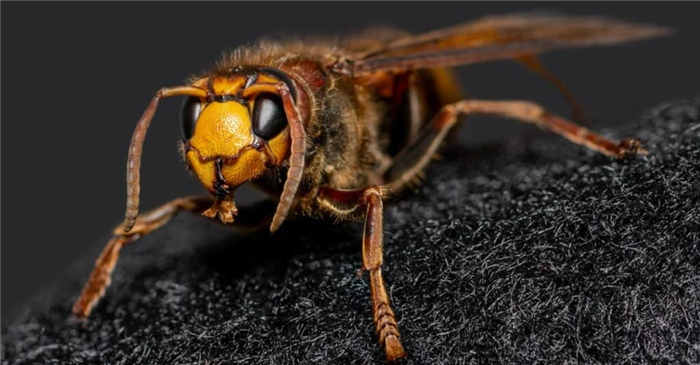
Wasps enjoy eating fruit from fruit trees, nectar from flowers, and insects.
In the wild, wasps eat a wide variety of food. The food that they eat varies according to the species and the environment where they live. Adult non-parasitic wasps mostly feed on nectar from plants. They are especially attracted to blue, white, purple, and yellow flowers, along with plants like spearmint. These wasps are also attracted to honey and to fruit trees, particularly fig trees. Additionally, they will eat the sweet secretions left behind by aphids, known as aphid honeydew. Some species also eat the secretions of their own larvae, which provide them with essential proteins. Meanwhile, predatory wasps tend to hunt and eat a slew of different prey. They tend to target insects such as caterpillars, beetles, crickets, and aphids. Also, some species have adapted to hunt spiders. When live prey is not readily available, wasps will also scavenge the remains of dead animals and insects.
What Do Captive Wasps Eat?
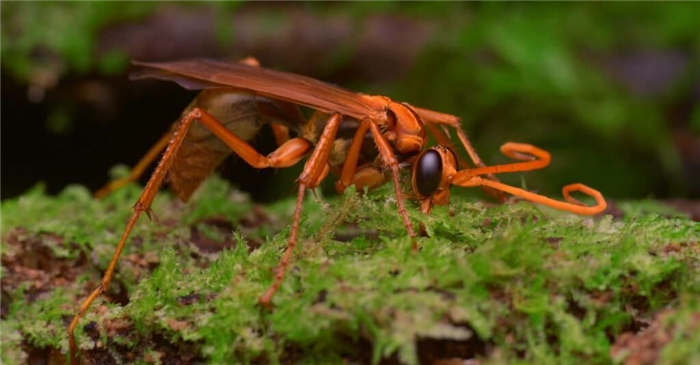
You’ll want to make sure pet wasps have access to plenty of fresh sugar water and insects.
At first glance, wasps don’t seem like they would make good pets. They are exactly affectionate, and there’s a possibility that they can sting you if they become aggravated. That said, some people enjoy keeping wasps as pets, both for the novelty and to observe their behavior. If you wish to keep pet wasps, you’ll need to know how to feed them appropriately. First, you’ll want to make sure your wasps have access to plenty of nectar. One of the best ways to simulate this is to provide them with sugar water. Just remember to replace the solution regularly to keep it from molding. Additionally, you’ll want to provide them with live prey. Small crickets are likely the easiest and most affordable insect prey. That said, caterpillars are an excellent option if you can find them. You can also provide them with fresh fruit or honey.
What Do Baby Wasps Eat?
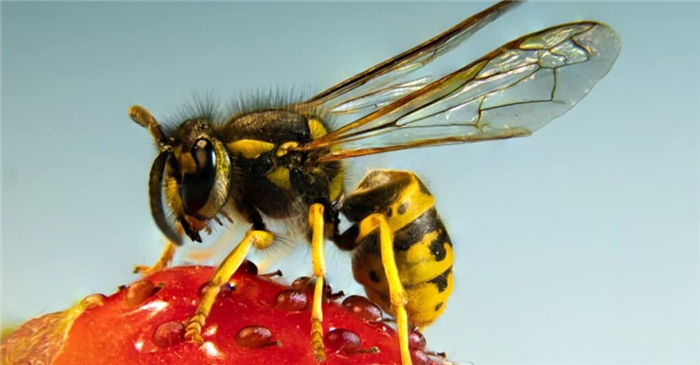
Baby wasps are usually born inside of a host insect before eating the host alive.
Wasps go through several life cycle stages before they fully mature into the fully mature adults we know. They begin life as eggs before evolving into larvae, pupae, and eventually adults. Female wasps will capture an insect and lay their eggs inside the prey. Once the eggs hatch, they will consume their insect host while it is still alive. Depending on the species, wasp mothers will employ different tactics of raising their young. Some will repeatedly feed their young chopped-up insects until they’re old enough to fend for themselves. Others will simply provide their babies with enough food to sustain them at once and seal them in a den away from predators until they’re ready to emerge. Generally speaking, the diet of baby wasps is almost completely carnivorous, consisting solely of insects like crickets, beetles, spiders, and caterpillars.
How Do Wasps Benefit a Garden?
Wasps have a bad wrap because their stings hurt. However, they serve a couple of useful purposes around your land.
If you’re an avid gardener, wasps are your friends. As they fly around feeding on your plants, they also help with pollination.
Wasps are good for more than pollinating, though. They also rid your plants of insects which harm your garden.
Because wasps are carnivorous, they eat many of the insects which do the greatest damage to your garden.
Are They Eating, Laying, or Feeding?
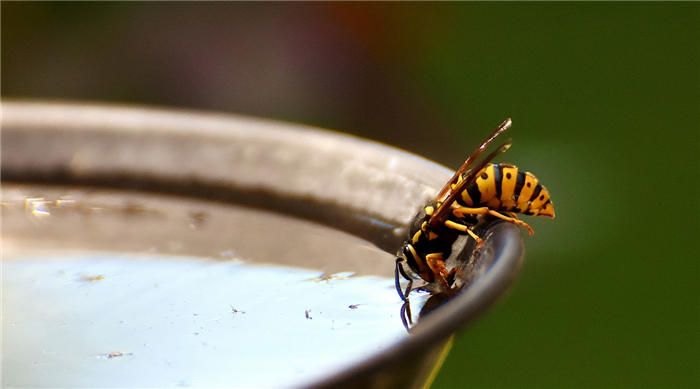
Wasps are interesting creatures. You may not have realized this because most of us try to keep our distance.
When you see a wasp flying around your garden, gathering food, you may not know what’s going on. I want to share a few interesting facts about wasps to spike your curiosity and increase your appreciation for these creatures too.
To begin, wasps don’t eat every insect they catch. Some they will choose to lay their eggs inside. The chosen insect becomes a host insect.
When wasps eat their prey, they paralyze them stopping their ability to fight back. Sometimes wasps will eat them, other times the wasps will place their eggs inside them.
As the eggs hatch, the larvae will remain safe inside the insect’s carcass. When the larvae grow into wasps, they’ll eat the insect they’ve been living inside of.
But what do they do for food while still in the larval state? Wasps don’t lay eggs and abandon them. Instead, the parent wasps will hunt insects, paralyze them, rip them apart, and drop the remains inside the host insect to allow the larvae to feed.
When you see a wasp flying around your area carrying food, you don’t know if it’s for their own sustenance, to lay their eggs inside, or to feed the young which have already hatched.
Hopefully, this information will give you a greater understanding of wasps. They do serve a useful purpose, but you may still wish to avoid them.
Take away their food source, and they’ll have less of a reason to hang around your homestead.
However, if you choose to embrace wasps, you may want to plant items which draw them in. This will allow the wasps to work for your property while you gain interesting insight about their ways… from a distance, of course.
Nature is quite fascinating. The more we study it and wonder what do wasps eat, the more amazed we should become by it.
